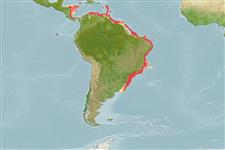>
Eupercaria/misc (Various families in series Eupercaria) >
Lutjanidae (Snappers) > Etelinae
Etymology: Pristipomoides: Greek, pristis = saw + Greek, poma, -atos = cover, operculum + Greek, oides = similar to (Ref. 45335).
Eponymy: Dr Harry Wyman Freeman (1923–2012) was Professor of Biology at College of Charleston, his alma mater. [...] (Ref. 128868), visit book page.
Environment: milieu / climate zone / depth range / distribution range
экология
морской демерсальный; пределы глубины 50 - 220 m (Ref. 47377), usually 50 - 150 m (Ref. 9626). Tropical; 35°N - 36°S, 86°W - 33°W (Ref. 55)
Western Atlantic: southeastern USA to Uruguay (Ref. 9626).
Size / Вес / Возраст
Maturity: Lm ? range ? - ? cm
Max length : 23.3 cm TL самец/пол неопределен; (Ref. 47377); common length : 21.0 cm TL самец/пол неопределен; (Ref. 9626)
колючие лучи спинного плавника (общее число) : 10; членистые (мягкие) лучи спинного плавника (общее число) : 12; колючие лучи анального плавника: 3; членистые (мягкие) лучи анального плавника: 8. Interorbital space flat. Eye large. Pectoral fins not reaching level of anus. Scale rows on back parallel to lateral line. Back and upper sides yellow-orange or pinkish; lower sides and belly silvery white; the caudal fin and the distal edge of the dorsal fin yellowish or orange; the remainder of the dorsal and other fins translucent or whitish.
Although the habitat is poorly known, most specimens have been trawled from relatively deep water at the upper edge of the continental shelf. Reported to occur on soft or semi-hard bottoms (Ref. 5217).
Life cycle and mating behavior
половая зрелость | размножение | нерест | икра | Fecundity | личинки
Allen, G.R., 1985. FAO Species Catalogue. Vol. 6. Snappers of the world. An annotated and illustrated catalogue of lutjanid species known to date. FAO Fish. Synop. 125(6):208 p. Rome: FAO. (Ref. 55)
Статус Красного Списка МСОП (Ref. 130435: Version 2024-1)
Угроза для людей
Harmless
Использование человеком
рыболовство: не имеет хозяйственного значения
дополнительная информация
инструменты
Специальные отчеты
Скачать в формате XML
ресурсы в Интернет
Estimates based on models
Preferred temperature (Ref.
123201): 17.2 - 26.3, mean 22.2 °C (based on 127 cells).
Phylogenetic diversity index (Ref.
82804): PD
50 = 0.5005 [Uniqueness, from 0.5 = low to 2.0 = high].
Bayesian length-weight: a=0.01514 (0.00722 - 0.03173), b=2.97 (2.80 - 3.14), in cm total length, based on LWR estimates for this species & Genus-body shape (Ref.
93245).
Trophic level (Ref.
69278): 3.7 ±0.5 se; based on size and trophs of closest relatives
устойчивость к внешним воздействиям (Ref.
120179): высокий, минимальное время удвоения популяции до 15 месяцев (Preliminary K or Fecundity.).
Fishing Vulnerability (Ref.
59153): Low vulnerability (13 of 100).
